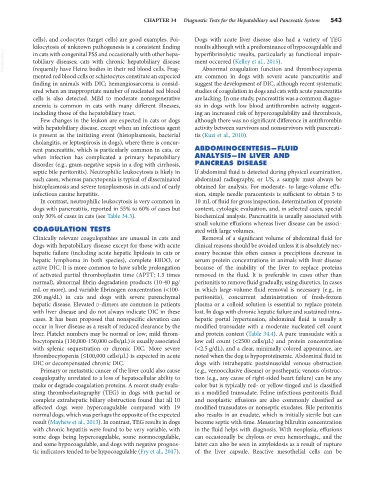Page 571 - Small Animal Internal Medicine, 6th Edition
P. 571
CHAPTER 34 Diagnostic Tests for the Hepatobiliary and Pancreatic System 543
cells), and codocytes (target cells) are good examples. Poi- Dogs with acute liver disease also had a variety of TEG
kilocytosis of unknown pathogenesis is a consistent finding results although with a predominance of hypocoagulable and
VetBooks.ir in cats with congenital PSS and occasionally with other hepa- hyperfibrinolytic results, particularly as functional impair-
ment occurred (Kelley et al., 2015).
tobiliary diseases; cats with chronic hepatobiliary disease
Abnormal coagulation function and thrombocytopenia
frequently have Heinz bodies in their red blood cells. Frag-
mented red blood cells or schistocytes constitute an expected are common in dogs with severe acute pancreatitis and
finding in animals with DIC; hemangiosarcoma is consid- suggest the development of DIC, although recent systematic
ered when an inappropriate number of nucleated red blood studies of coagulation in dogs and cats with acute pancreatitis
cells is also detected. Mild to moderate nonregenerative are lacking. In one study, pancreatitis was a common diagno-
anemia is common in cats with many different illnesses, sis in dogs with low blood antithrombin activity suggest-
including those of the hepatobiliary tract. ing an increased risk of hypercoagulability and thrombosis,
Few changes in the leukon are expected in cats or dogs although there was no significant difference in antithrombin
with hepatobiliary disease, except when an infectious agent activity between survivors and nonsurvivors with pancreati-
is present as the initiating event (histoplasmosis, bacterial tis (Kuzi et al., 2010).
cholangitis, or leptospirosis in dogs), where there is concur-
rent pancreatitis, which is particularly common in cats, or ABDOMINOCENTESIS—FLUID
when infection has complicated a primary hepatobiliary ANALYSIS—IN LIVER AND
disorder (e.g., gram-negative sepsis in a dog with cirrhosis, PANCREAS DISEASE
septic bile peritonitis). Neutrophilic leukocytosis is likely in If abdominal fluid is detected during physical examination,
such cases, whereas pancytopenia is typical of disseminated abdominal radiography, or US, a sample must always be
histoplasmosis and severe toxoplasmosis in cats and of early obtained for analysis. For moderate- to large-volume effu-
infectious canine hepatitis. sion, simple needle paracentesis is sufficient to obtain 5 to
In contrast, neutrophilic leukocytosis is very common in 10 mL of fluid for gross inspection, determination of protein
dogs with pancreatitis, reported in 55% to 60% of cases but content, cytologic evaluation, and, in selected cases, special
only 30% of cases in cats (see Table 34.3). biochemical analysis. Pancreatitis is usually associated with
small volume effusions whereas liver disease can be associ-
COAGULATION TESTS ated with large volumes.
Clinically relevant coagulopathies are unusual in cats and Removal of a significant volume of abdominal fluid for
dogs with hepatobiliary disease except for those with acute clinical reasons should be avoided unless it is absolutely nec-
hepatic failure (including acute hepatic lipidosis in cats or essary because this often causes a precipitous decrease in
hepatic lymphoma in both species), complete EBDO, or serum protein concentrations in animals with liver disease
active DIC. It is more common to have subtle prolongation because of the inability of the liver to replace proteins
of activated partial thromboplastin time (APTT; 1.5 times removed in the fluid. It is preferable in cases other than
normal), abnormal fibrin degradation products (10-40 µg/ peritonitis to remove fluid gradually, using diuretics. In cases
mL or more), and variable fibrinogen concentration (<100- in which large-volume fluid removal is necessary (e.g., in
200 mg/dL) in cats and dogs with severe parenchymal peritonitis), concurrent administration of fresh-frozen
hepatic disease. Elevated D-dimers are common in patients plasma or a colloid solution is essential to replace protein
with liver disease and do not always indicate DIC in these lost. In dogs with chronic hepatic failure and sustained intra-
cases. It has been proposed that nonspecific elevation can hepatic portal hypertension, abdominal fluid is usually a
occur in liver disease as a result of reduced clearance by the modified transudate with a moderate nucleated cell count
liver. Platelet numbers may be normal or low; mild throm- and protein content (Table 34.4). A pure transudate with a
bocytopenia (130,000-150,000 cells/µL) is usually associated low cell count (<2500 cells/µL) and protein concentration
with splenic sequestration or chronic DIC. More severe (<2.5 g/dL), and a clear, minimally colored appearance, are
thrombocytopenia (≤100,000 cells/µL) is expected in acute noted when the dog is hypoproteinemic. Abdominal fluid in
DIC or decompensated chronic DIC. dogs with intrahepatic postsinusoidal venous obstruction
Primary or metastatic cancer of the liver could also cause (e.g., venoocclusive disease) or posthepatic venous obstruc-
coagulopathy unrelated to a loss of hepatocellular ability to tion (e.g., any cause of right-sided heart failure) can be any
make or degrade coagulation proteins. A recent study evalu- color but is typically red- or yellow-tinged and is classified
ating thromboelastography (TEG) in dogs with partial or as a modified transudate. Feline infectious peritonitis fluid
complete extrahepatic biliary obstruction found that all 10 and neoplastic effusions are also commonly classified as
affected dogs were hypercoagulable compared with 19 modified transudates or nonseptic exudates. Bile peritonitis
normal dogs, which was perhaps the opposite of the expected also results in an exudate, which is initially sterile but can
result (Mayhew et al., 2013). In contrast, TEG results in dogs become septic with time. Measuring bilirubin concentration
with chronic hepatitis were found to be very variable, with in the fluid helps with diagnosis. With neoplasia, effusions
some dogs being hypercoagulable, some normocogulable, can occasionally be chylous or even hemorrhagic, and the
and some hypocoagulable, and dogs with negative prognos- latter can also be seen in amyloidosis as a result of rupture
tic indicators tended to be hypocoagulable (Fry et al., 2017). of the liver capsule. Reactive mesothelial cells can be

